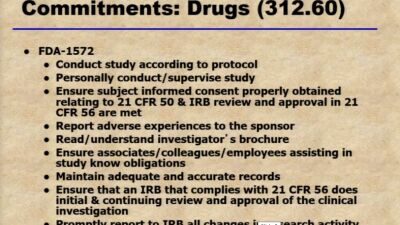- FDA Administration
- FDA’s mission is to be responsible for protecting public health
- Interstate jurisdiction
- Compliance secured through programs like BIMO
- Bioresearch monitoring programs (BIMO)
- Clinical investigators (CIs)
- Institutional review boards (IRBs)
- Sponsors/Monitors/CROs
- Radioactive drug research committee
- In-vivo bioequivalence
- Good laboratory practices (GLP)
- Clinical investigator commitments on drugs & devices
- The consent process
- Informed consent
- Basic elements of the consent process
- Non-English speaking process
- Clinical investigator and their responsibilities
- All changes
- All unanticipated problems
- Safety reports
- Report days
- Inspection assignments
- Issued by FDA centers to field
- Duration: 7 days or longer
- Inspection assignment: site selection
- More inspections while trials are on-going
- “Risk-based” site selection
- FDA investigator’s background
- Field investigators – minimum 4 years college degree
- FDA trained to conduct inspections of clinical investigations
- Experience in conducting inspections of clinical investigators
- Inspection activates
- Announce inspection
- Opening interview
- Interviewing staffs
- Reviewing study documents – informed consents, administrative records, etc.
- Critical issues
- Study supervision
- Exit interview – may issue an FDA-483
- Post Inspection
- Establishment inspection report (EIR)
- EIR reviewed by FDA HQ staff
- Final classification sent to field office
- Reviewing FDA center sends letter to clinical investigator after review
- Field sends FMD-145 letter with copy of report to clinical investigator
- Also available to anyone through FOIA
- Possible outcomes of FDA clinical investigator inspections
- Administrative actions:
- Warning letters
- Clinical holds
- Rejection of data
- Etc.
- Administrative actions:
- Common deficiencies at clinical sites
- Failure to follow the protocol and/or regulations
- Protocol deviations
- Inadequate and inaccurate records
- Inadequate accountability
- Inadequate communication with the IRB
- Inadequate subject protection
- Tips for a successful study
- Enhance study adherence
- Simple protocol design
- Essential data points
- Avoid ambiguity and vagueness
- Fully understand protocol limits
- All records should meet the ALCOA test
- Enhancing record quality
- Understand regulatory responsibility
- Communication is important
Regulatory Science Symposium: Clinical Trials Hurdles Session 3 - FDA GCP Inspections (2015)
In this series, we will discuss how the FDA investigators would conduct their GCP investigation.
Course Syllabus/Topic
Acknowledgement
Accompanying text created by Annie Ly | Undergraduate Research Associate and Provost's First Generation Research Fellow | lyannie@usc.edu

